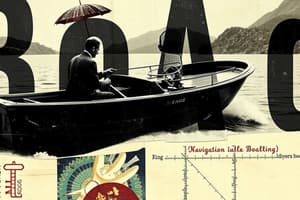Podcast
Questions and Answers
Before casting off, keep your boat tied to the dock while you ___ the engine.
Before casting off, keep your boat tied to the dock while you ___ the engine.
warm up
What should you ensure everyone on board is wearing before casting off?
What should you ensure everyone on board is wearing before casting off?
personal flotation device (PFD)
Which of these procedures are for small, single-engine boats?
Which of these procedures are for small, single-engine boats?
- Docking With No Wind or Current
- Casting Off With No Wind or Current
- Before Casting Off
- Before Casting Off: Important (correct)
What is the first step when casting off with no wind or current?
What is the first step when casting off with no wind or current?
When the area is clear of traffic, continue your ___ before docking.
When the area is clear of traffic, continue your ___ before docking.
The vessel that maintains its course and speed is referred to as the stand-on vessel.
The vessel that maintains its course and speed is referred to as the stand-on vessel.
Which vessel is required to take early action to avoid a collision?
Which vessel is required to take early action to avoid a collision?
What is the meaning of 'underway' in boating terms?
What is the meaning of 'underway' in boating terms?
Which light indicates a vessel's port (left) side?
Which light indicates a vessel's port (left) side?
You must give way to a sailing vessel when operating a power-driven vessel unless the sailing vessel is overtaking.
You must give way to a sailing vessel when operating a power-driven vessel unless the sailing vessel is overtaking.
Match the following types of vessels with their definitions:
Match the following types of vessels with their definitions:
What should you do if you see a red and a white light while on a power-driven vessel?
What should you do if you see a red and a white light while on a power-driven vessel?
What does a single prolonged blast signal indicate?
What does a single prolonged blast signal indicate?
What is one of the three major responsibilities of every boater?
What is one of the three major responsibilities of every boater?
Which of these causes the most collisions?
Which of these causes the most collisions?
Flashcards are hidden until you start studying
Study Notes
Before Casting Off
- Secure the boat to the dock while warming up the engine and ensuring all on board are seated and wearing personal flotation devices (PFDs).
- Confirm the engine's functionality and check that the departure area is clear.
Casting Off Procedures
- Procedures differ for small single-engine boats compared to larger vessels, sailboats, or twin-engine boats.
- For casting off in calm conditions, release bow and stern lines, shift to forward gear, and gradually steer away from the dock.
Casting Off with Wind or Current
- When wind or current pushes towards the dock, secure the bow line mid-boat after casting off the stern line, ensuring fenders are positioned on the bow.
- Briefly engage forward gear and steer away from the dock before casting off the bow line.
Docking Procedures
- Reduce speed to maintain steerage and use reverse to halt away from the dock.
- Observe wind/current directions while stationary to plan the approach. Approach into the stronger force for better control and have lines ready.
Docking With Different Conditions
- Docking in calm conditions requires a slow, angled approach, securing the bow line upon passenger disembarkation, then swinging the stern in.
- In windy or current conditions, approach parallel to the dock, allowing the forces to guide the boat, and secure lines once settled.
Responsibilities of a Boater
- Boaters must practice good seamanship, maintain vigilance, and ensure safe speeds to avoid collisions.
- Safe speed allows time to react and stop appropriately, varying based on environmental and traffic conditions.
Navigational Rules and Vessel Types
- Give-way vessels must yield by stopping or changing course, while stand-on vessels maintain speed and direction unless necessary.
- Vessels include power-driven, sailing vessels, and vessels engaged in fishing with various movement capabilities.
Risk of Collision and Light Signals
- A risk of collision arises when vessels are on a direct approach or looming large vessels.
- For power-driven vessel encounters:
- Green and white lights indicate stand-on status.
- A white light suggests the vessel is either anchored or being overtaken.
- A combination of red, green, and white signals prompts both vessels to give way.
Sound Signals for Communication
- One short blast: "Passing on my port side."
- Two short blasts: "Passing on my starboard side."
- Three short blasts: "Operating astern propulsion."
- Prolonged blasts signal vessel operation, while five rapid blasts indicate danger or confusion.
Navigating at Night
- Ensure all navigation lights function and have spare bulbs. Use an all-round white light when anchored and reduce speed for safety.
- Always be cautious of visible obstacles and avoid solitary navigation at night.
Summary of Key Learning Points
- Mastery of casting off and docking under various conditions.
- Understanding the responsibilities of boat operation to ensure safety and compliance with navigation rules.
- Ability to interpret navigation lights, sound signals, and procedures for encountering other vessels.
Studying That Suits You
Use AI to generate personalized quizzes and flashcards to suit your learning preferences.




